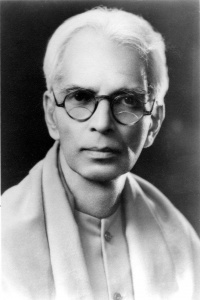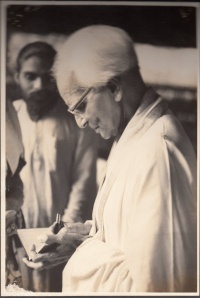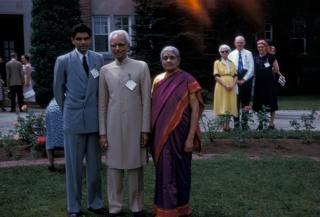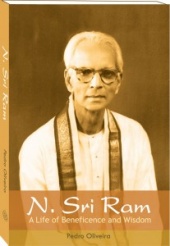Nilakanta Sri Ram: Difference between revisions
No edit summary |
|||
| Line 18: | Line 18: | ||
== Theosophical work == | == Theosophical work == | ||
During the administration of [[George S. Arundale]], Mr. Sri Ram held office as Treasurer (1937-1939), Recording Secretary (1939-1941), and then Vice President (1942-1946). When [[Curuppumullage Jinarājadāsa|C. Jinarājadāsa]] succeeded Mr. Arundale, Mr. Sri Ram began lecturing abroad more extensively. He spoke in many countries of Europe, North and South America, Australia, New Zealand, India, Pakistan, Bangladesh, Sri Lanka, and Burma. Mr. Jinarājadāsa greatly valued his advice and assistance, | During the administration of [[George S. Arundale]], Mr. Sri Ram held office as Treasurer (1937-1939), Recording Secretary (1939-1941), and then Vice President (1942-1946). When [[Curuppumullage Jinarājadāsa|C. Jinarājadāsa]] succeeded Mr. Arundale, Mr. Sri Ram began lecturing abroad more extensively. He spoke in many countries of Europe, North and South America, Australia, New Zealand, India, Pakistan, Bangladesh, Sri Lanka, and Burma. | ||
Mr. Jinarājadāsa greatly valued his advice and assistance and wanted Mr. Sri Ram to succeed him in the presidency. Suffering from ill health, Raja retired from the presidency in 1953. Mr. Sri Ram received 36 nominations as a candidate to become president; [[Sidney A. Cook]] received 17; [[Rukmini Devi Arundale]] received 16; and other candidates included [[Josephine Ransom]], [[Ernest Wood]], and [[James S. Perkins]]. Cook withdrew from the race, leaving Rukmini in competition with her brother for the office, but Sri Ram ultimately won the election.<ref>"News and Notes: From the Recording Secretary," ''The American Theosophist'' 40.12 (December, 1952), 238.</ref> Mr. Cook continued in his position as Vice President. | |||
== Presidency == | == Presidency == | ||
Revision as of 17:57, 10 March 2016
Nilakanta Sri Ram (15 December 1889 - 8 April 1973) was an Indian Theosophist who served as the fifth International President of the Theosophical Society based in Adyar, Chennai, India. He was much loved as a teacher, lecturer, and writer. A phrase that epitomizes his philosophy is,
- When you are one with every heart that beats, you are nothing in yourself.[1]
Early days
Nilakanta Sri Ram was born on December 15, 1889 in Thanjavur, Tamil Nadu, India. His parents, A. Nilakanta Sastry and his wife Seshammal, were both Theosophists. After attending the Hindu High School in Madras (now Chennai), he completed a Bachelor’s degree from the University of Madras, majoring in Mathematics.
“Born renounced”
Born into a Brahman family, he made a break with the tradition of appending “Sastri” or “Sarma” to his surname, which would have indicated his high caste. His younger brother, N. S. Sastry, wrote of him as being “born renounced.”[2] He led a life of simplicity, humility, generosity, and detachment, and quietly achieved much without drawing attention to himself.
Educational work
Sri Ram was a teacher at the Besant Theosophical College in Madanapalle, the National School in Bangalore, and the National University of India in Chennai. All of these were schools established by Annie Besant in her initiative to improve Indian education.
Work with Annie Besant
He became Assistant Editor of New India, the daily newspaper published by Annie Besant. He helped in her work with the Home Rule League, and helped to draft the Commonwealth of India Bill that was presented before the British Parliament on December 9, 1925. During her final years, 1929-1933, he served as her personal secretary, and was at her bedside when she passed away.
Theosophical work
During the administration of George S. Arundale, Mr. Sri Ram held office as Treasurer (1937-1939), Recording Secretary (1939-1941), and then Vice President (1942-1946). When C. Jinarājadāsa succeeded Mr. Arundale, Mr. Sri Ram began lecturing abroad more extensively. He spoke in many countries of Europe, North and South America, Australia, New Zealand, India, Pakistan, Bangladesh, Sri Lanka, and Burma.
Mr. Jinarājadāsa greatly valued his advice and assistance and wanted Mr. Sri Ram to succeed him in the presidency. Suffering from ill health, Raja retired from the presidency in 1953. Mr. Sri Ram received 36 nominations as a candidate to become president; Sidney A. Cook received 17; Rukmini Devi Arundale received 16; and other candidates included Josephine Ransom, Ernest Wood, and James S. Perkins. Cook withdrew from the race, leaving Rukmini in competition with her brother for the office, but Sri Ram ultimately won the election.[3] Mr. Cook continued in his position as Vice President.
Presidency
Mr. Sri Ram assumed the Presidency of the Society on February 17, 1953. During his term in office, the Adyar Library and Research Centre was shifted out of the headquarters building into a new structure. Another new building was created to house the Vasanta Press, with the cornerstone laid on April 3, 1968. On that same day, International Vice President James S. Perkins and his wife Kathrine presented a new printing press from Germany and binding equipment from Switzerland, gifts of The Kern Foundation.[4]
During his years in office he toured the world almost every year, participating in conventions and lecturing at lodges. He was often accompanied by his wife and son. He also lectured regularly at the School of the Wisdom, and some of those talks were assembled into book form, ‘’The Way of Wisdom.”
In 1968 death claimed his dear wife Bhagirathi.[5] He passed away on April 8, 1973, and was succeeded by John B. S. Coats after an interim in which Vice President James S. Perkins served as Acting President.
Freemasonry
Mr. Sri Ram was a member of Le Droit Humain.
Writings
Writing was always a major activity in Mr. Sri Ram's life. He wrote editorials for The Theosophist, numerous journal articles, and several books. The Union Index of Theosophical Periodicals has hundreds of articles written by or about Sri Ram in this list. They include articles published in many prominent Theosophical journals: The Theosophist, The American Theosophist, Theosophical Digest, The Light Bearer, Theosophy in New Zealand, Theosophy in Australia, The Theosophical Journal, and Le Lotus Bleu, among others.
His books included:
- A Theosophist Looks at the World Adyar, Chennai, India: Theosophical Publishing House, 1950.
- An Approach to Reality and Man. Adyar, Chennai, India: Theosophical Publishing House, 1951.
- Man, His Origins and Evolution Adyar, Chennai, India: Theosophical Publishing House, 1952.
- Thoughts for Aspirants Adyar, Chennai, India: Theosophical Publishing House, 1957. Available in part at Katinkahesselink.net.
- On the Watch Tower, Selected Editorial Notes from "The Theosophist, 1953-1966". Adyar, Chennai, India: Theosophical Publishing House, 1966. A compilation of his articles.
- The Human Interest and Other Addresses and Short Essays. Adyar, Chennai, India: Theosophical Publishing House, 1968, and previous edition published around 1951.
- Life's Deeper Aspect Adyar, Chennai, India: Theosophical Publishing House, 1968.
- Seeking Wisdom Adyar, Chennai, India: Theosophical Pub. House, 1969.
- The Nature of Our Seeking, 1973.
- The Way of Wisdom Adyar, Chennai, India: Theosophical Publishing House, 1989. A collection of talks presented at the School of the Wisdom in Adyar on J. Krishnamurti's At the Feet of the Master, H.P. Blavatsky's The Voice of the Silence, Mabel Collins's Light on the Path, and the Bhagavadgita, given on different occasions during the years 1956 to 1964.
He also wrote booklets, all published by the Theosophical Publishing House in Adyar:
- Theosophy, the Divine Wisdom, 1960.
- The Real Work of the Theosophical Society
- The Ancient Wisdom from the Modern Standpoint
- Theosophical Education
- Buddhism, Northern and Southern, 1957. A lecture given at the 81st Convention of the Theosophical Society on December 30, 1956.
- Death and Its Meaning, 1959.
- Human Regeneration, 1992.
- Consciousness, Its Nature and Action, 1964 Blavatsky Lecture. Available at hpb.narod.ru.
- Modifications of the Mind
- The Significance of Each Present Moment
- Evolution and Life, 1957.
- Undiscovered Powers in Man and Nature
- Inaugural address of N. Sri Ram: and other speeches on Feb. 17 and 24, 1953, 1953. Souvenir booklet.
- President's Address: Delivered on Re-election February 17, 1960.
- An Address to New Members, 1958. Originally in The Theosophist, v. 79, February, 1958.
Awards and honors
In 1951, Mr. Sri Ram was awarded the Subba Row Medal for his contributions to Theosophical literature.
Additional resources
Biographies and articles
- Oliveira, Pedro. N. Sri Ram: A Life of Beneficence and Wisdom. Adyar: Theosophical Publishing House, 2009.
- '’The Theosophist’’ of June, 1973 was a memorial issue following his death.
- "Sri Ram, Nilakanta" biographical sketch in Theosopedia.
- "N. Sri Ram: International President of the Theosophical Society, 1889-1973" biographical sketch in Theosophy Cardiff.
- "Nilakanta Sri Ram" brief biographical sketch and several articles at Katinkahesselink.net.
- "N. Sri Ram" biographical sketch at Theosophical Society, Cardiff Lodge web page.
- "Nilakanta Sri Ram: A Tribute" by S. Narayanaswamy at Yabaluri.org.
Audio
- Numerous recorded lectures are available in CD format for download at Theosophical Society in America web page, for sale at Quest Books and for loan at the Henry S. Olcott Memorial Library.
Video
- Perspectives on N. Sri Ram's Teachings by Radha Burnier
Notes
- ↑ Sigvaldi Hjalmarsson, "One with Every Heart", The Theosophist (June 1973), 175-178.
- ↑ N. S. Sastry, “Born Renounced”, ‘’The Theosophist’’ Vol. 94 (June, 1973), 206.
- ↑ "News and Notes: From the Recording Secretary," The American Theosophist 40.12 (December, 1952), 238.
- ↑ "Adyar's New Printing Press," The American Theosophist 55.6 (June, 1967), 137.
- ↑ N. Sri Ram, "Presidential Address," The Report of the Theosophical Society, 1968 (Adyar, Chennai, India: Theosophical Publishing Company, 1969), 7.



